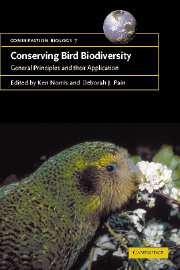Book contents
- Frontmatter
- Contents
- List of contributors
- Preface
- 1 Biodiversity – evolution, species, genes
- 2 Why conserve bird diversity?
- 3 Mapping and monitoring bird populations: their conservation uses
- 4 Priority-setting in species conservation
- 5 Selecting sites for conservation
- 6 Critically endangered bird populations and their management
- 7 Diagnosing causes of population declines and selecting remedial actions
- 8 Outside the reserve: pandemic threats to bird biodiversity
- 9 Predicting the impact of environmental change
- 10 Fragmentation, habitat loss and landscape management
- 11 The interface between research, education and training
- 12 Conservation policies and programmes affecting birds
- References
- Index
Preface
Published online by Cambridge University Press: 10 December 2009
- Frontmatter
- Contents
- List of contributors
- Preface
- 1 Biodiversity – evolution, species, genes
- 2 Why conserve bird diversity?
- 3 Mapping and monitoring bird populations: their conservation uses
- 4 Priority-setting in species conservation
- 5 Selecting sites for conservation
- 6 Critically endangered bird populations and their management
- 7 Diagnosing causes of population declines and selecting remedial actions
- 8 Outside the reserve: pandemic threats to bird biodiversity
- 9 Predicting the impact of environmental change
- 10 Fragmentation, habitat loss and landscape management
- 11 The interface between research, education and training
- 12 Conservation policies and programmes affecting birds
- References
- Index
Summary
The death of a pigeon called Martha in Cincinnati Zoo on 1st September 1914 was a significant event. She was the last passenger pigeon (Ectopistes migratorius) in existence. In 1878 the total population of passenger pigeons was estimated at 50 million birds, roaming the forests of the eastern United States. By March 1900, the last individual was killed in the wild (see Wilcove 1999). Although the dodo (Raphus cucullatus) of Mauritius has become a symbol of extinction and the efforts of conservationists to save endangered species, the story of the passenger pigeon is probably a starker example of the capacity of human activities to threaten the Earth's biodiversity.
Sadly, the passenger pigeon is not an isolated example. In its latest assessment, BirdLife International describes 1,186 species of bird that are currently threatened with extinction worldwide. A total of 128 species are believed to have become extinct in the last 500 years, 103 of these since 1800 (BirdLife International 2000). The rate at which bird species are being lost is currently much more rapid than at any time in the evolutionary history of this group (F.D.M. Smith et al. 1993; Pimm et al. 1995). The loss of biodiversity is not just the random deletion of species – certain families are more at risk than others. This bias in the extinction process means we are not just losing individual bird species, but significant parts of the Earth's evolutionary history (e.g. Purvis et al. 2000).
- Type
- Chapter
- Information
- Conserving Bird BiodiversityGeneral Principles and their Application, pp. ix - xivPublisher: Cambridge University PressPrint publication year: 2002

